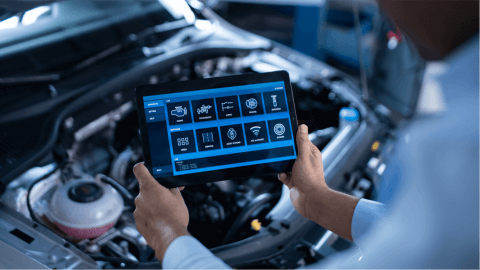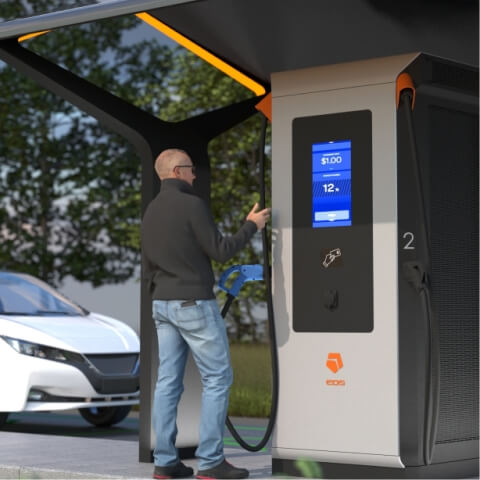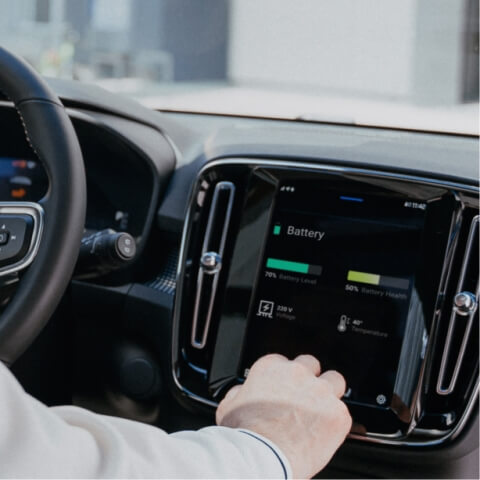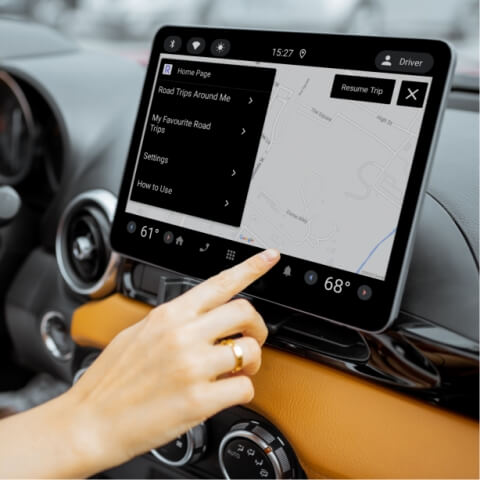Europe's electric vehicle (EV) market is thriving, with over 2.2 million electrified cars registered across the European Union, Switzerland, Norway, and Iceland in 2025. New registrations are up 34% compared to the same period in the previous year. This substantial increase underscores the region’s ongoing transition towards electrified mobility.
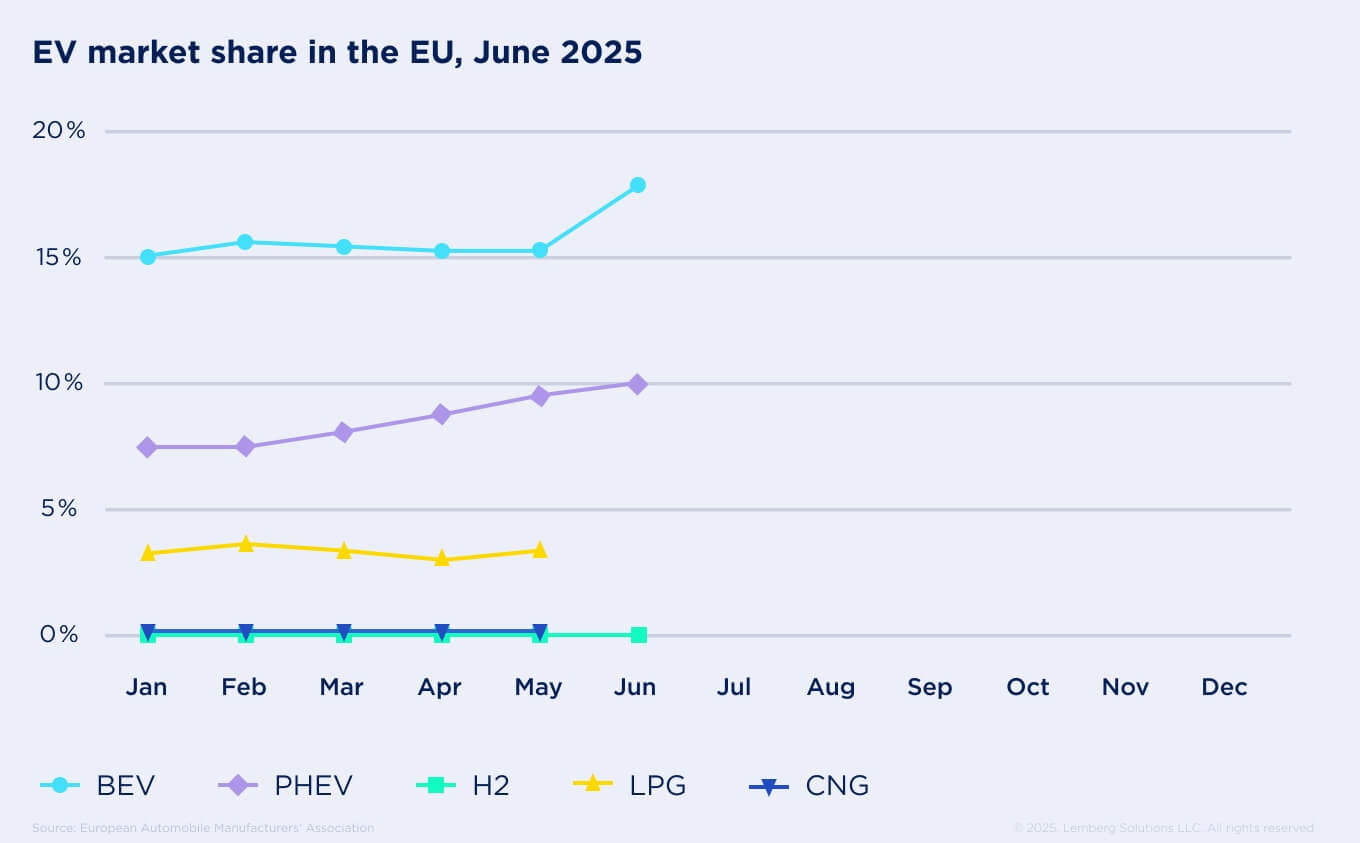
Subsequently, public charging stations have doubled in the past 2 years to keep up with growing EV demand. Meanwhile, the number of smart chargers, with power ratings of 150 kilowatts (kW) and above, grew twice in 2024 and now accounts for nearly 10% of all public fast chargers, according to Global EV Outlook 2025.
Yet, every opportunity brings its own set of challenges. On the one hand, the emerging EV industry creates demand for appropriate charging infrastructure and offers a huge opportunity both for Charge Point Operators (CPOs) and businesses entering the market. On the other hand, the accelerating rollout of publicly accessible chargers necessitates that EV charging software and hardware meet a growing range of regulatory demands and industry standards.
Let’s explore the regulations and standards that guide EV charging software developers in creating compliant, future‑ready solutions for EV charging infrastructure.
Regulatory drivers: how AFIR and Fit for 55 influence EV charging infrastructure
The adoption of EV chargers in Europe is fueled by green initiatives introduced by the EU and aimed at reducing CO2 emissions from transportation in the upcoming years.
The European Green Deal and Fit for 55
Introduced in 2019, the European Green Deal reflects a shared commitment among EU member states to address climate change and transition toward a more resource-efficient economy. For the automotive industry, this meant reducing greenhouse gas emissions and achieving economic growth without dependence on non-renewable resources. As a result, a Fit for 55 package called for reducing Europe’s CO2 emissions by at least 55% by 2030 compared to 1990 levels.
Alternative Fuels Regulation (AFIR)
To help Europe achieve the desired result, the European Commission came up with the Alternative Fuels Infrastructure Regulation (AFIR), or Regulation 2023/1804, published in 2023. AFIR EV charging requirements establish mandatory minimum charging speeds and maximum distances between charging stations along the Trans-European Transport Network (TEN-T), which forms the backbone of Europe’s road infrastructure.
AFIR sets the following objectives for the European EV charging infrastructure:
- Infrastructure. The regulation mandates that publicly accessible charging infrastructure must provide a minimum total power output of 1.3 kW per registered battery-electric vehicle (BEV) and 0.8 kW per registered plug-in hybrid vehicle (PHEV) across Europe. Charging stations are to be installed every 60 kilometers on major highways and an adequate number of charging points in urban areas must be ensured.
- Smart charging. Under AFIR, smart charging refers to the ability of charging stations to manage power delivery based on real-time signals and grid conditions. This ensures efficient energy use, improves grid stability, and provides users with transparent pricing, availability, and seamless access across interoperable networks.
- Pricing transparency and data accessibility. AFIR mandates CPOs to ensure their infrastructure offers ad-hoc payment options, displaying clear and comparable pricing, and providing real-time data on charger availability and status.
The challenges of non-compliance
For businesses, AFIR requirements might not only be an opportunity, but a significant barrier to charging station operators and investors.
At Lemberg Solutions, our energy software engineers understand the complexities of standard compliance for EV charging software development and how to navigate them effectively. Our team has the expertise to design and develop software that meets OCPP, ISO 15118, AFIR, and other EU requirements, ensuring interoperability, security, and market readiness.
One of the key issues is the high cost of existing software modernization, as well as building new charging points with heightened demands. Installing a charging station with a power output of at least 150 kW requires not only specialized hardware. It also needs advanced software systems for energy management, user interaction, and backend integration.
Failing to meet European EV charging compliance quickly undermines customer trust and stalls business growth. Non‑compliance with AFIR can lead blocked market entry and steep fines, forcing costly retrofits before deployment. For example, businesses can pay as much as €1,000 daily for every charging point required under the AFIR but not yet installed.
Launching chargers without proper OCPP implementation, for example, makes a charging station unable to connect to major networks, making them useless for many EV drivers. Skipping ISO 15118’s security provisions could leave systems exposed to cyberattacks that disrupt operations or compromise payment data. Even small oversights, such as ignoring metering accuracy standards, can lead to disputes over billing and damage a company's reputation.

Security and compliance for EV charging software development
EU NIS2 directive and Cyber Resilience Act
The NIS2 Directive is an EU legislation governing cybersecurity across critical infrastructure. Given their direct connection to the power grid and their role in processing sensitive user and payment data, EV charging networks clearly fall within this scope.
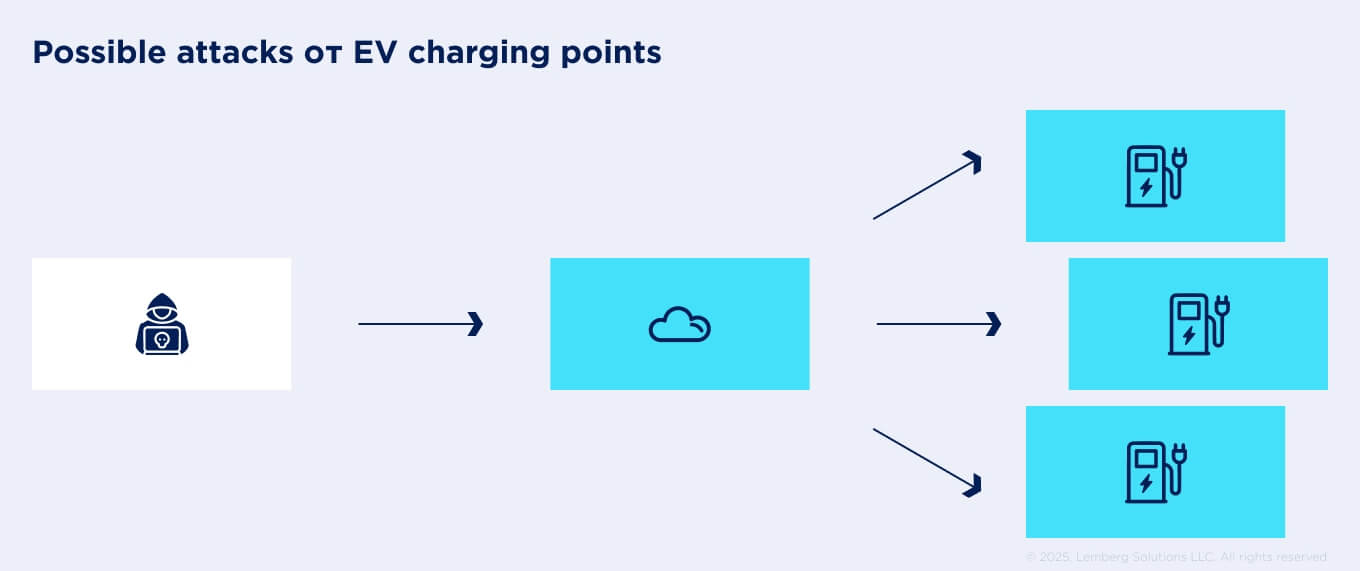
As cyberattacks on automotive rose by 39% last year, the urgency for strong security measures is growing. Particularly, EV charging software must implement strong access controls, encryption, and continuous monitoring to protect against cyber threats.
The EU Cyber Resilience Act (CRA) also has a significant effect on developing and maintaining EV charging station compliance. The acts aim to improve the security of digital products and services by requiring formal third-party certification and rigorous breach reporting. Noncompliance will expose providers to penalties including fines up to €15 million or 2.5% of global turnover.
EV charging standards to comply with
In the context of developing EV charging infrastructure in Europe, relevant standards and protocols play a critical role in ensuring interoperability, user safety across a rapidly expanding network of public and private charging stations.
OCPP
OCPP, or Open Charge Point Protocol, is an open communication protocol that enables interoperability and communication between EV charging stations and central management systems (CMS). The main purpose of the OCPP is to enable standardized communication between electric vehicle (EV) charging stations and central management systems, regardless of vendor or manufacturer.
It ensures interoperability, allowing CPOs to mix and match hardware and software from different providers while maintaining full control over charging operations, data exchange, remote monitoring, billing, and diagnostics. As such, following OCPP enables different brands of chargers and back-end systems to interoperate, thereby reducing vendor lock-in and fostering a more flexible and scalable charging infrastructure.

ISO 15118
ISO 15118-20 is applied to enable secure and intelligent communication between electric vehicles (EVs) and the charging infrastructure for both AC and DC charging.
For EV charging software developers, following the ISO 15118 EV charging standard helps support seamless charging experiences and advanced energy management features.
By following the standard’s requirements, software engineers can create proper Plug & Charge functionality, which allows EVs to automatically authenticate and initiate charging without the need for RFID cards or mobile apps, simplifying the user experience. It also implies bidirectional charging capabilities, enabling vehicles to return electricity to the grid through vehicle-to-grid (V2G) integration.
Thus, adopting ISO 15118‑20 in EV charging software development not only ensures compliance and interoperability but also positions businesses to offer faster charging, attract more network partners, and stay competitive in the rapidly growing EV market.

OCPI
The Open Charge Point Interface (OCPI) is a communication protocol that enables interoperability between different charging networks. It allows CPOs and e-Mobility Service Providers (eMSPs) to exchange information such as charging station availability, pricing, and user authentication in real time.
Simply put, following OCPI in EV charging software development makes it easier for different charging networks to work together, manage pricing easily, and stay competitive in the growing European EV market. OCPI supports roaming, remote session control, and billing, making it possible for EV drivers to access and pay for charging across multiple networks using a single app or account. Widely adopted in Europe, OCPI plays a key role in building an open, user-friendly, and scalable EV charging ecosystem.
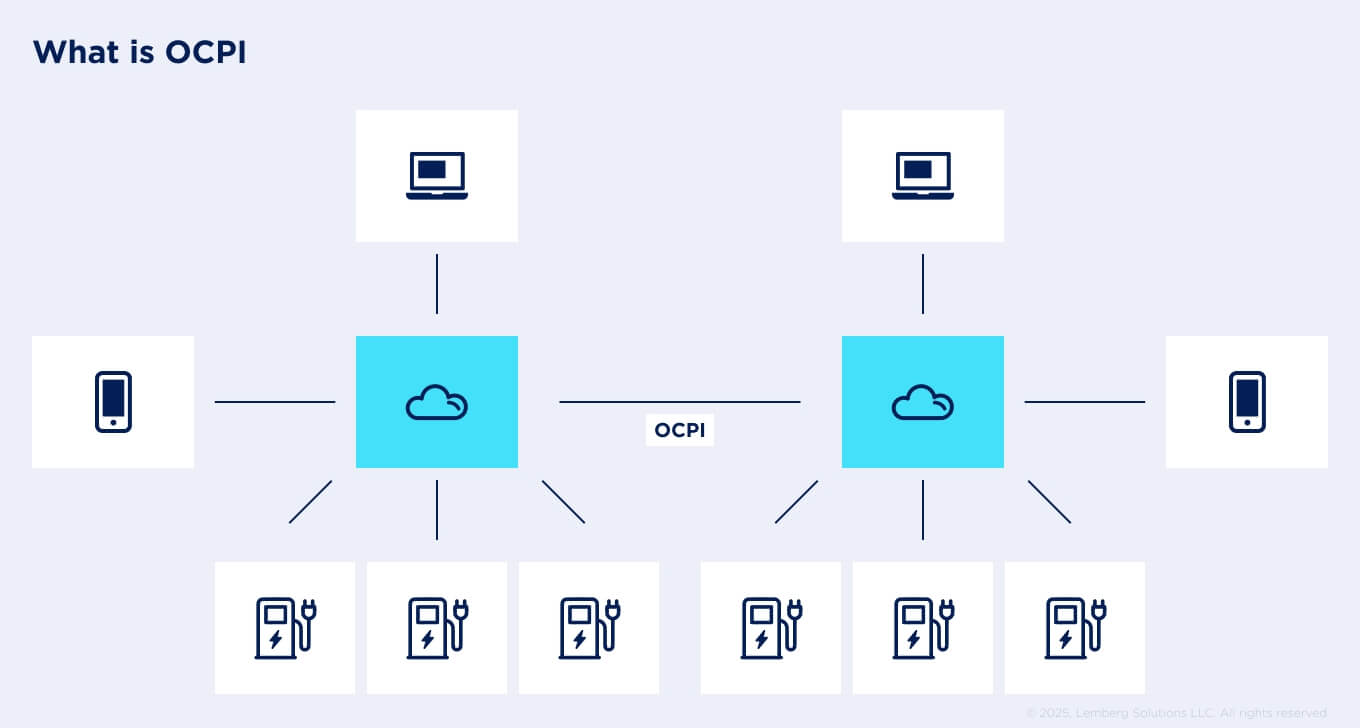
IEC 61851
IEC 61851 defines the requirements for EV conductive charging systems. It provides the foundation for the design, installation, and operation of both AC and DC charging equipment, covering aspects such as safety in automotive, communication between vehicle and charger, power delivery, and environmental conditions. The standard has several parts, including general requirements (IEC 61851-1), and specific guidelines for AC/DC charging systems (IEC 61851-22 and IEC 61851-23, respectively).

IEC 62196
IEC 62196 is a key international standard that defines the connectors and charging interfaces for EV chargers, with particular relevance across Europe. It outlines technical specifications for various connector types to support both AC and DC charging. By standardizing these interfaces, IEC 62196 ensures safe, efficient, and interoperable EV charging across different markets and regions worldwide.
As the EU accelerates EV adoption under AFIR, adherence to these standards is essential for the development of EV charging infrastructure, enabling seamless cross-border charging, and supporting a safe, scalable transition to electric mobility.
Read more about compliant engineering in automotive.
Standardized charging methods
Standardized charging methods ensure that all electric vehicles can access a common, interoperable charging network, regardless of brand or region. Simply put, American and Chinese EVs also drive in Europe, so it is necessary to pay attention to the following standards:
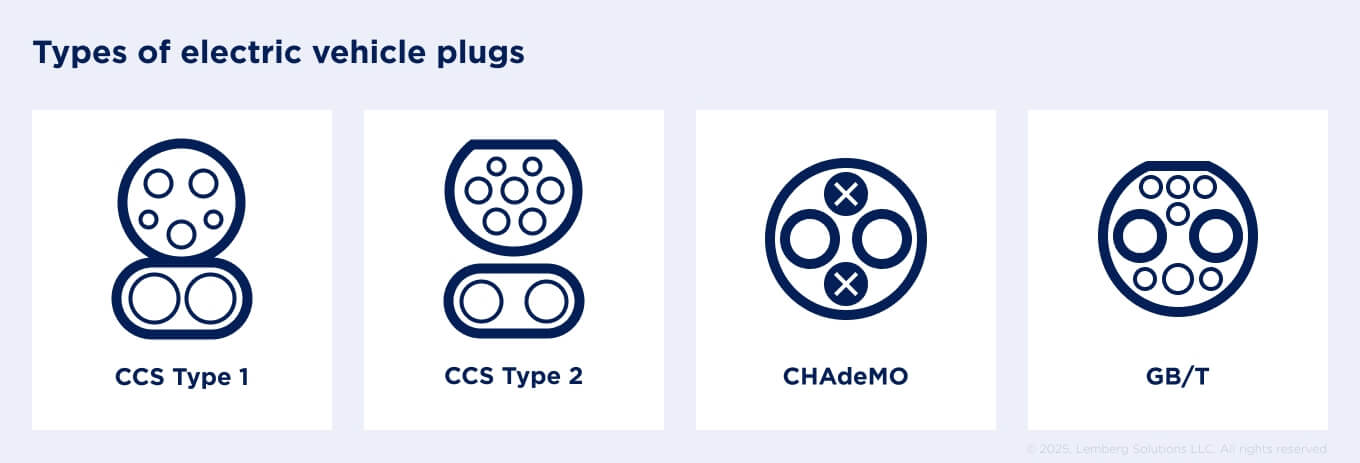
CCS
The CCS (Combined Charging System) is a standardized charging method for electric vehicles and allows for both slow (AC) and fast (DC) charging using the same port. CCS chargers can provide power to electric vehicle batteries at up to 500 kW, and in response to demands for even faster charging, 400 kW and 990 kW CCS chargers have been demonstrated.
CHAdeMO
CHAdeMO is a fast-charging system for battery electric vehicles, developed in Japan by the CHAdeMO Association, formed by the Tokyo Electric Power Company and five major Japanese automakers. It allows providing power to EVs at 400 kW direct current. The Association is currently co-developing with China Electricity Council (CEC) the third-generation standard that aims to deliver 900 kW.
CHAdeMO charging connectors are still available in Europe, but their usage is declining as CCS becomes the dominant standard for new electric vehicle (EV) models and charging stations. While CHAdeMO played a significant role in the early adoption of DC fast charging in Europe, the market is shifting to CCS.
GB/T
The GB/T charging standard, primarily the GB/T 20234, is a set of charging station standards used in China for AC and DC fast charging of plug-in electric vehicles, known locally as "new-energy vehicles". GB/T 27930 provides communication requirements, corresponding to ISO 15118.
EV charging standard compliance made easy with LS software development services
At Lemberg Solutions, we deeply understand the importance of secure and compliant EV charging infrastructure. Our team has experience in developing AFIR-compliant EV chargers that rigorously follow OCPP and ISO 15118. Specifically, we bring hands-on experience in implementing OCPP with full support for all required profiles, including Smart Charging, AutoCharge, and Composite Schedule management.

With Lemberg Solutions, you're not just getting a development team but partnering with engineers who understand the core mechanics of the most important protocols and standards in EV charging infrastructure development.





